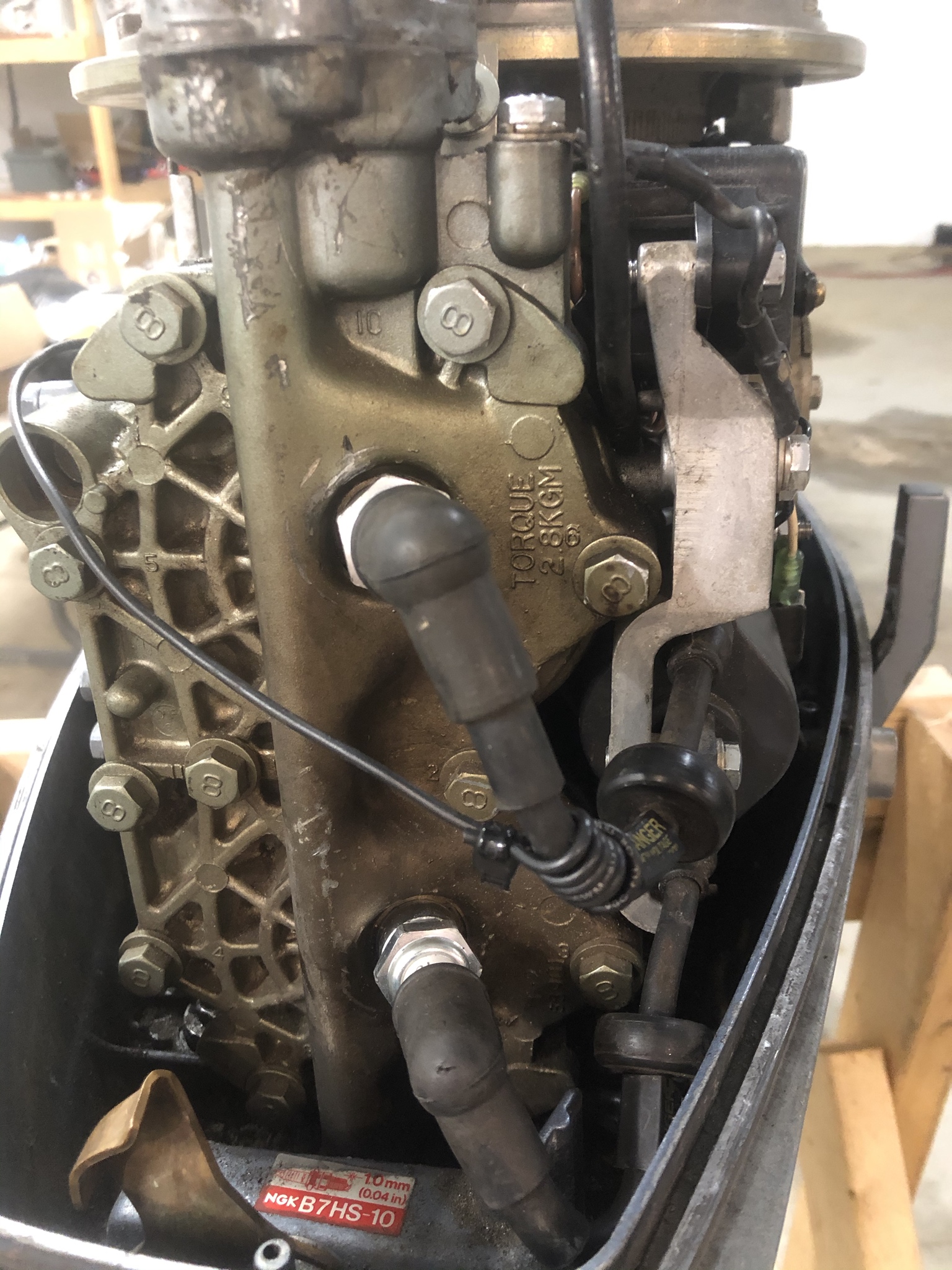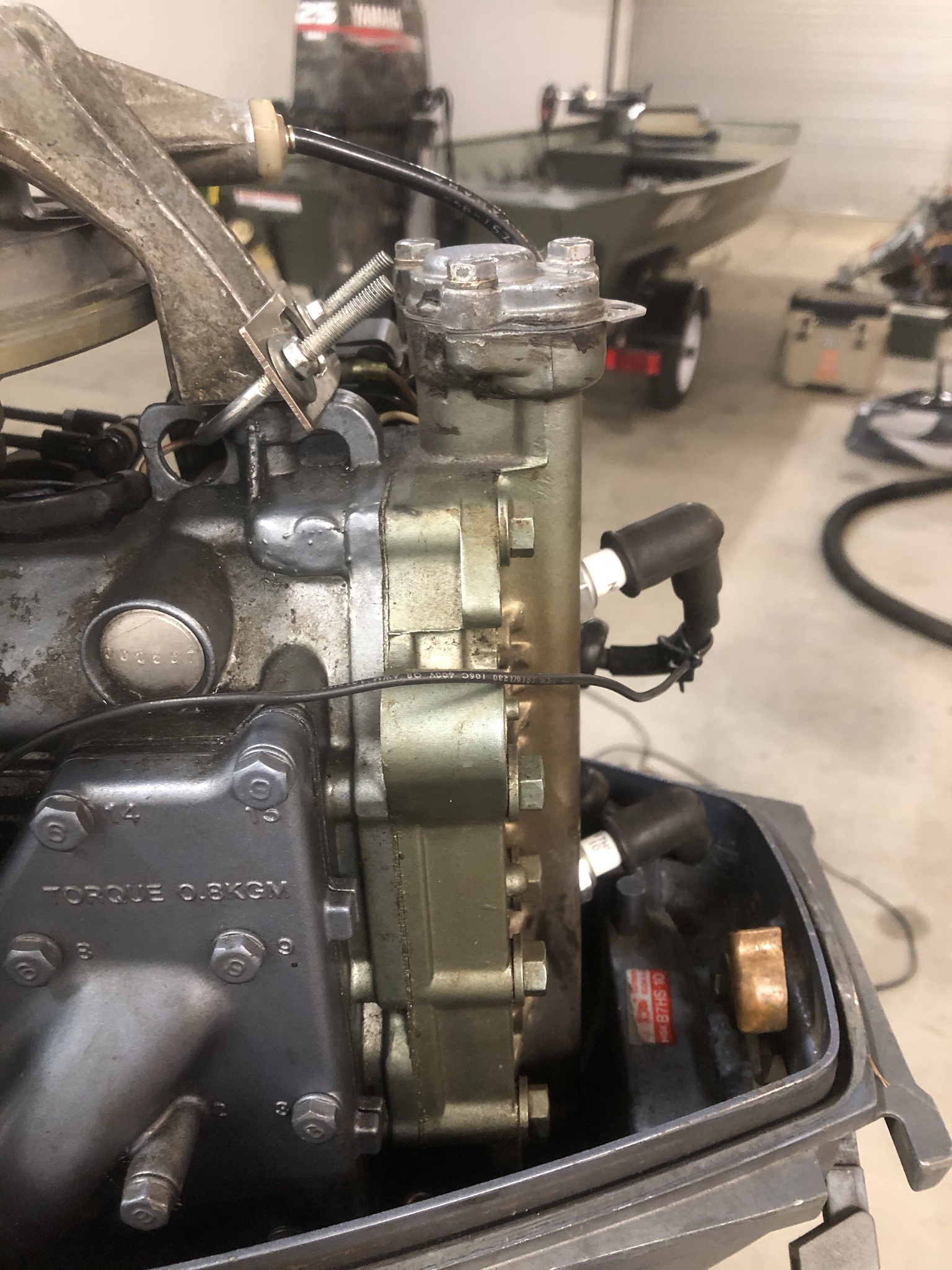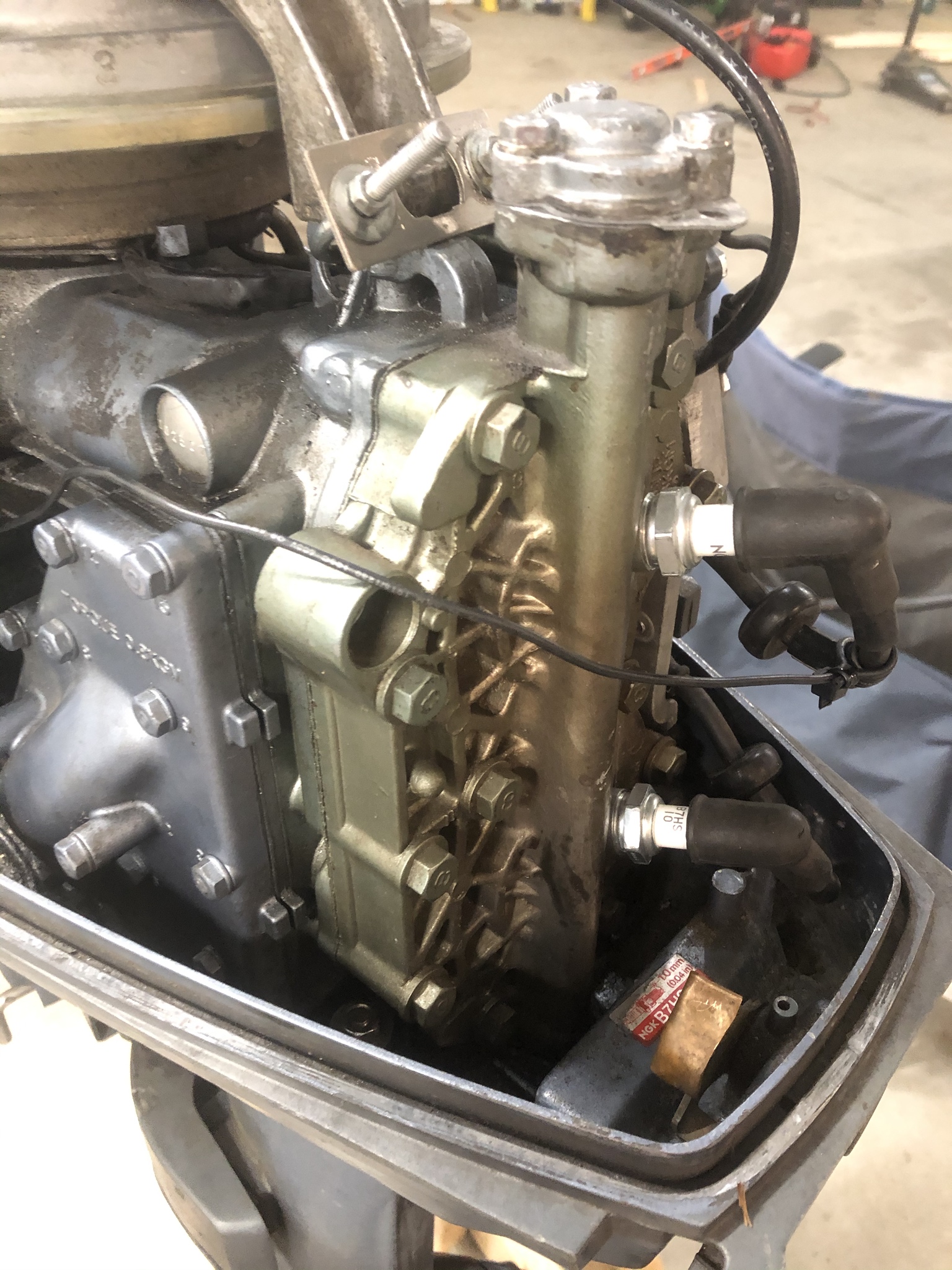wmk0002
Well-known member
A friend bought a 1986 Yamaha 25hp (25SJ). Motor had 120 psi on both cylinders and was in good shape overall. I'll note that the head is a gold color while the rest of the motor looks more like a factory blue and the thermostat was broken and stuck in the open position.
We ran it as is at first and it started pretty easy and ran but very poorly both on muffs and in a barrel. It would cough very hard every so often. Let it run in a barrel for a while one day and it died and wouldn't restart. Compression was still good but it had an incredibly weak spark when using an air gap tester. Pulled the coil to find that one of the two leads from the CDI was melted through and exposing the wire where it contacted the powerhead. Also noticed that the starting lockout cable that runs near that area was melted to the metal sleeve. We checked the primary and secondary winding of the coil and both were in spec so I temporarily taped up the exposed wire and reinstalled. Still weak to no spark. We pulled the CDI and tried bench testing it but pretty much every combination showed an open circuit. Unsure if it was in fact dead, we ordered a fairly cheap used one that was said to have come off of a running motor that had an internal failure. Installed the used one and had very nice spark jumping 3/4" gap on both leads. So we are thinking that this motor overheated in the past and either damaged the CDI with heat, or by having the output wire to the coil shorting out. Also of note, the charge and pulse coils under the flywheel tested within spec.
While waiting on that part, we rebuilt the carb and checked the timing. Timing was good and the carb was not too dirty and after blowing out all orifices with solvent and compressed air seemed pretty spotless. After we have the CDI on we run it in a barrel and get it to start easy and run very well at neutral and forward idle. I do have to set the mixture screw to 2.5 turns out which is a lot but it runs pretty well there. Also set the forward idle to 750 rpms. We lake test that same afternoon...it starts first pull and appears to be running well. Slowly accelerate, where it does seem to have a slight miss or something off at maybe 1500 rpms, but it quickly clears out and accelerates strong and smooth up to around 3000 rpms where it then begins to sound like it is missing hard and is shaking and only climbs to maybe 3100 rpms.
From there did the typical stuff... checked tank vent - open, checked bulb - firm, tried squeezing bulb - no change in performance, inspected the fuel filter - full and free of air bubbles or noticeable debris at idle and WOT, checked the throat at WOT - good spray of fuel coming from the main nozzle, pull the choke at WOT - engine bogged down to an idle and cleared itself out after removing choke, checked engine temperature and water pump - both fine. Called it quits and drove back to the ramp. It never died and continued to run well and feel powerful in that lower half of the rpm range. After getting back, checked the fuel pump and it was in great shape including the diaphragm. Spark was still strong as well. Plugs also looked a little dark but not overly rich but the return trip to the ramp in the good performance window may have cleaned them off.
Now to present time, we are somewhat stumped. Granted one of the simplest things yet to do is change the plugs, which we will do asap, but aside from that not really sure what to try next. I feel like the on the water tests tell me that it isn't' a fuel starvation issue but more so another ignition issue. I guess its possible it could be getting too much fuel but I know the float height appears good and the only thing I may be missing is if someone did some home handywork on the main jet size. The ignition coil tests ok but I'm wondering if it was heat damaged as well or due to the bare wire arcing/shorting. Ive seen a number of bad powerpacks/CDIs fail due to heat but only one other coil I can think of. I think the coil is the next item to replace since it has the bad input wire already. I was thinking maybe cover it in heat shrink and call it good but IDK if that is an acceptable fix.
I'd appreciate some thoughts on what we may have missed or if anyone has any insight on the potential ignition system issues. I really want to help him get this one going as he got burned on the last one he bought when he didn't check compression prior to buying. But also since it isnt my motor its on him to decide what all he wants to spend on it to try to get it going. BTW, the boat is a 1542 Fisher mod-v which runs out great at 21-22 mph with two adults and gear so I don't think setup is at play here.
We ran it as is at first and it started pretty easy and ran but very poorly both on muffs and in a barrel. It would cough very hard every so often. Let it run in a barrel for a while one day and it died and wouldn't restart. Compression was still good but it had an incredibly weak spark when using an air gap tester. Pulled the coil to find that one of the two leads from the CDI was melted through and exposing the wire where it contacted the powerhead. Also noticed that the starting lockout cable that runs near that area was melted to the metal sleeve. We checked the primary and secondary winding of the coil and both were in spec so I temporarily taped up the exposed wire and reinstalled. Still weak to no spark. We pulled the CDI and tried bench testing it but pretty much every combination showed an open circuit. Unsure if it was in fact dead, we ordered a fairly cheap used one that was said to have come off of a running motor that had an internal failure. Installed the used one and had very nice spark jumping 3/4" gap on both leads. So we are thinking that this motor overheated in the past and either damaged the CDI with heat, or by having the output wire to the coil shorting out. Also of note, the charge and pulse coils under the flywheel tested within spec.
While waiting on that part, we rebuilt the carb and checked the timing. Timing was good and the carb was not too dirty and after blowing out all orifices with solvent and compressed air seemed pretty spotless. After we have the CDI on we run it in a barrel and get it to start easy and run very well at neutral and forward idle. I do have to set the mixture screw to 2.5 turns out which is a lot but it runs pretty well there. Also set the forward idle to 750 rpms. We lake test that same afternoon...it starts first pull and appears to be running well. Slowly accelerate, where it does seem to have a slight miss or something off at maybe 1500 rpms, but it quickly clears out and accelerates strong and smooth up to around 3000 rpms where it then begins to sound like it is missing hard and is shaking and only climbs to maybe 3100 rpms.
From there did the typical stuff... checked tank vent - open, checked bulb - firm, tried squeezing bulb - no change in performance, inspected the fuel filter - full and free of air bubbles or noticeable debris at idle and WOT, checked the throat at WOT - good spray of fuel coming from the main nozzle, pull the choke at WOT - engine bogged down to an idle and cleared itself out after removing choke, checked engine temperature and water pump - both fine. Called it quits and drove back to the ramp. It never died and continued to run well and feel powerful in that lower half of the rpm range. After getting back, checked the fuel pump and it was in great shape including the diaphragm. Spark was still strong as well. Plugs also looked a little dark but not overly rich but the return trip to the ramp in the good performance window may have cleaned them off.
Now to present time, we are somewhat stumped. Granted one of the simplest things yet to do is change the plugs, which we will do asap, but aside from that not really sure what to try next. I feel like the on the water tests tell me that it isn't' a fuel starvation issue but more so another ignition issue. I guess its possible it could be getting too much fuel but I know the float height appears good and the only thing I may be missing is if someone did some home handywork on the main jet size. The ignition coil tests ok but I'm wondering if it was heat damaged as well or due to the bare wire arcing/shorting. Ive seen a number of bad powerpacks/CDIs fail due to heat but only one other coil I can think of. I think the coil is the next item to replace since it has the bad input wire already. I was thinking maybe cover it in heat shrink and call it good but IDK if that is an acceptable fix.
I'd appreciate some thoughts on what we may have missed or if anyone has any insight on the potential ignition system issues. I really want to help him get this one going as he got burned on the last one he bought when he didn't check compression prior to buying. But also since it isnt my motor its on him to decide what all he wants to spend on it to try to get it going. BTW, the boat is a 1542 Fisher mod-v which runs out great at 21-22 mph with two adults and gear so I don't think setup is at play here.





